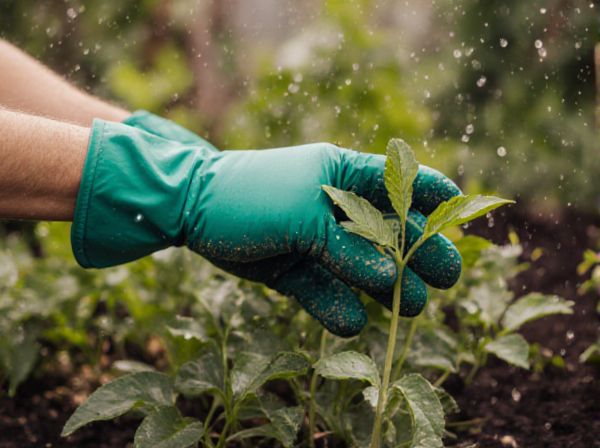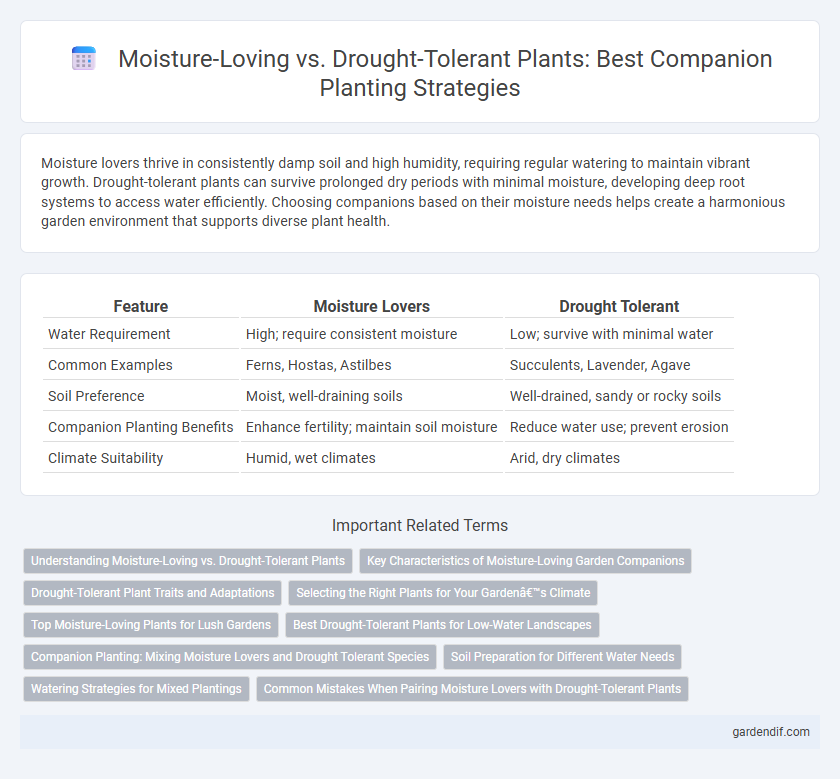
Moisture lovers vs drought tolerant Illustration
Moisture lovers thrive in consistently damp soil and high humidity, requiring regular watering to maintain vibrant growth. Drought-tolerant plants can survive prolonged dry periods with minimal moisture, developing deep root systems to access water efficiently. Choosing companions based on their moisture needs helps create a harmonious garden environment that supports diverse plant health.
Table of Comparison
| Feature | Moisture Lovers | Drought Tolerant |
|---|---|---|
| Water Requirement | High; require consistent moisture | Low; survive with minimal water |
| Common Examples | Ferns, Hostas, Astilbes | Succulents, Lavender, Agave |
| Soil Preference | Moist, well-draining soils | Well-drained, sandy or rocky soils |
| Companion Planting Benefits | Enhance fertility; maintain soil moisture | Reduce water use; prevent erosion |
| Climate Suitability | Humid, wet climates | Arid, dry climates |
Understanding Moisture-Loving vs. Drought-Tolerant Plants
Moisture-loving plants thrive in consistently damp environments, requiring regular watering and rich, well-drained soils to prevent root rot and promote healthy growth. Drought-tolerant plants have adapted to survive with minimal water by developing deep root systems, reduced leaf surface area, and water-storing tissues, making them ideal for xeriscaping and arid regions. Understanding the water needs and adaptations of these plant types is essential for selecting appropriate companions that ensure garden sustainability and aesthetic balance.
Key Characteristics of Moisture-Loving Garden Companions
Moisture-loving garden companions thrive in consistently damp soil, featuring lush foliage and deep root systems that prevent waterlogging. These plants excel in high-humidity environments, often exhibiting broad leaves for efficient water absorption and transpiration. Their key characteristics include tolerance to partial shade, rapid growth in moist conditions, and the ability to enhance soil moisture retention, making them ideal for water-abundant garden areas.
Drought-Tolerant Plant Traits and Adaptations
Drought-tolerant plants exhibit deep root systems, thick cuticles, and reduced leaf surface areas to minimize water loss and maximize water uptake in arid environments. Their physiological adaptations include stomatal regulation and osmotic adjustment, allowing them to maintain cellular function under prolonged dry conditions. These traits enable drought-tolerant species to thrive in companionship with moisture lovers by occupying different ecological niches and optimizing overall garden resilience.
Selecting the Right Plants for Your Garden’s Climate
Moisture-loving plants such as ferns and hostas thrive in consistently damp environments, making them ideal for gardens with high humidity or frequent rainfall. In contrast, drought-tolerant species like succulents and lavender require well-drained soil and minimal watering, perfect for arid climates or areas with water restrictions. Selecting plants based on your garden's moisture availability ensures healthier growth and sustainable landscape management.
Top Moisture-Loving Plants for Lush Gardens
Top moisture-loving plants such as hostas, ferns, and astilbes thrive in consistently damp soil, making them ideal companions for shaded or partially shaded garden areas. These plants excel in retaining lush greenery and vibrant blooms due to their preference for high humidity and well-watered conditions. Incorporating moisture lovers alongside drought-tolerant species enhances garden biodiversity while ensuring optimized water use and visual appeal in varying microclimates.
Best Drought-Tolerant Plants for Low-Water Landscapes
Best drought-tolerant plants for low-water landscapes include succulents like agave and aloe, native grasses such as blue grama, and Mediterranean herbs like lavender and rosemary. These plants thrive with minimal irrigation by storing water in leaves or deep root systems, making them ideal companions for xeriscaping projects. Incorporating drought-resistant companions reduces water consumption while maintaining vibrant, sustainable garden aesthetics.
Companion Planting: Mixing Moisture Lovers and Drought Tolerant Species
Companion planting that mixes moisture-loving species like basil and lettuce with drought-tolerant plants such as lavender and rosemary helps optimize garden water usage by creating microclimates that reduce evaporation. This strategic pairing improves overall plant health and resilience, as moisture lovers benefit from the shade and wind protection provided by drought-tolerant neighbors. Integrating diverse water needs within the same garden bed enhances soil structure and nutrient cycling, promoting sustainable growth.
Soil Preparation for Different Water Needs
Moisture lovers thrive in consistently damp soil rich in organic matter, requiring well-prepared soil with ample mulch and regular watering to maintain optimal moisture levels. In contrast, drought-tolerant companions need well-draining soil with added sand or gravel to prevent water retention and promote root aeration during dry periods. Tailoring soil preparation to these distinct water needs improves plant health and supports a sustainable companion planting environment.
Watering Strategies for Mixed Plantings
Watering strategies for mixed plantings must account for moisture lovers and drought-tolerant companions by zoning plants with similar hydration needs together, ensuring efficient water use. Deep, infrequent watering benefits drought-tolerant species by promoting root resilience, whereas frequent, shallow watering supports moisture-loving plants requiring consistent soil dampness. Combining drip irrigation systems with mulching optimizes moisture retention and reduces water stress, enhancing overall plant health and growth.
Common Mistakes When Pairing Moisture Lovers with Drought-Tolerant Plants
Pairing moisture-loving plants with drought-tolerant species often leads to overwatering issues or insufficient hydration for one group, as their water needs greatly differ. Common mistakes include placing them in the same irrigation zone or soil type, which results in poor growth or plant stress. Proper companion planting requires segregating these plants based on their moisture preferences to ensure optimal health and vitality.
Moisture lovers vs drought tolerant Infographic

 gardendif.com
gardendif.com